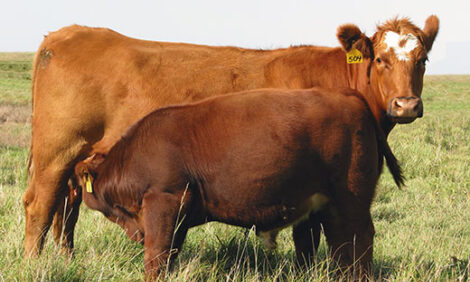



Nebraska researcher using cattle genetics, microbiome data to predict performance
Drew Lakamp is researching if genetics impact the microbiomeUniversity of Nebraska-Lincoln doctorate candidate Drew Lakamp is researching if an animal’s genetics impact its microbiome. This information could be used to predict cattle performance and help reduce diseases in cattle through genetic selection, according to a news release from the university.
Lakamp is from New Berlin, Illinois, and studying animal breeding and genetics. After graduation, Lakamp is hoping to do a combination of teaching, research, and Extension outreach to producers for a land-grant university.
Lakamp became interested in genetics as a child when he was showing cattle. It is expensive to buy high-quality show cattle. Lakamp found that it was cheaper to buy semen and eggs rather than a live animal. While he never got to build the show string of his dreams, this realization set his life’s trajectory. Lakamp knew he wanted to get a doctorate in animal breeding and came to finish his education at UNL because he believes it has one of the best beef research programs. Lakamp is working under Matt Spangler, a professor of animal science.
Research and impact in the beef industry
A microbiome is a population of microorganisms that live in or on an animal. A lot of microbes have a mutualistic relationship with their host. The host gives them a safe place to live and food to eat, and in return, the microbes do something beneficial like digesting plant matter the animal cannot or stimulating the immune system. Other microbes don’t serve any particular function but don’t harm the host. If given the chance, some microbes can cause disease.
One aspect of Lakamp’s research is looking at the microbiome in the eyes of cattle. The goal of this aspect is to see if the proportions of different bacteria that are living on a calf’s eye are influenced by the calf’s genetics. If this is the case, Lakamp believes pinkeye can be reduced through genetic selection.
The other research aspect is looking at the gut microbiome of cattle, seeing if there is a connection between the microbiome and the animal’s own genetics, and using that information to make predictions about how that animal will perform in the future.
There is data that shows a direct relationship between microbiome composition and performance as well as separate data showing a direct relationship between genetics and performance. Overall, Lakamp’s research is investigating if animal performance and microbiome or genetic data can be used to predict the performance of an animal with microbiome or genetic data available.
“From an oral swab it is possible to get information about a calf’s genetics and what kind of bacteria, archaea, fungi, and whatever else live in its rumen, or a rough approximation thereof,” said Lakamp. “In the future, it could be possible to predict the performance of animals based on information from their genome, microbiome, and actual performance data of related animals. This means we could predict with a certain degree of accuracy what the average daily gain of a calf, who has yet to enter the feedlot stage, will be.”
Should Lakamp’s research show an animal’s microbiome is impacted by its genetics, animals could be selectively bred to limit the number of disease-causing agents to survive in that animal.
Lakamp is excited about being closer to being able to put a phenotypic prediction into producers' hands. This information helps them make decisions about their operations and use precision management with cattle.
Challenges and opportunities
Lakamp sees big data, or tons of information, as a challenge and opportunity.
“When the microbiologist hands me information, I have 43 million data points for each animal,” said Lakamp. “That’s a lot of data, and that’s not counting the genomic data that I have as well. So, how do you deal with that?”
It is challenging to work with that volume of data, but once a system is figured out to work with numerous data points, scientists can optimize the amount of information they get from the data and translate it into actionable items producers can use.



